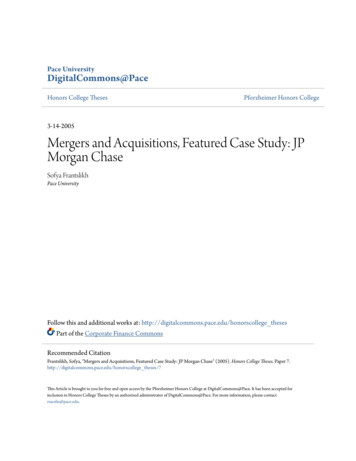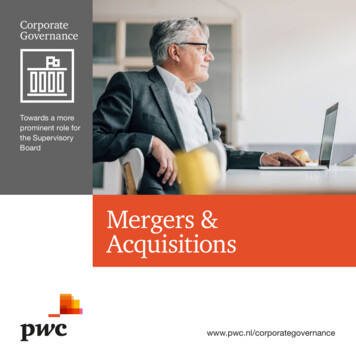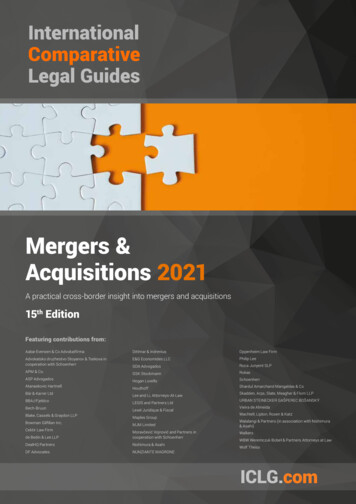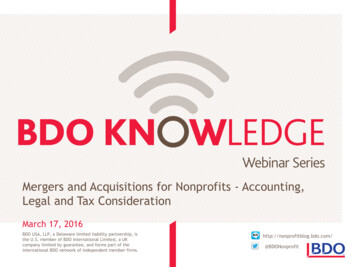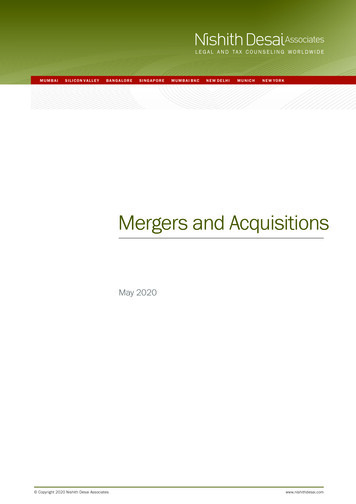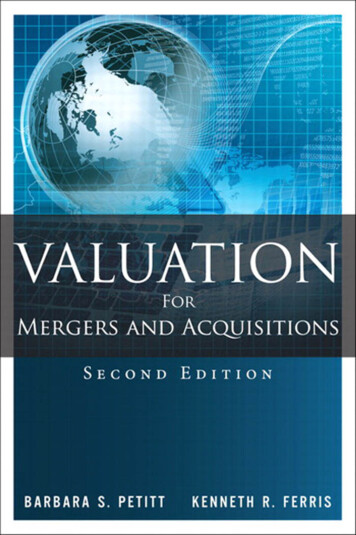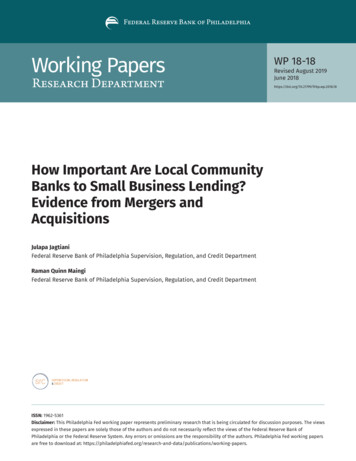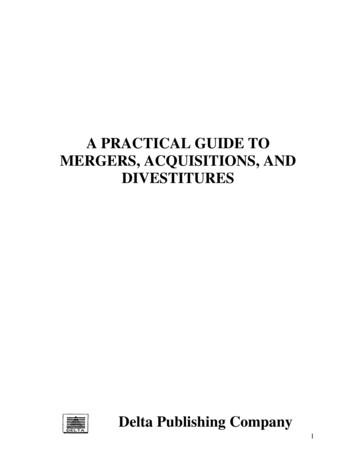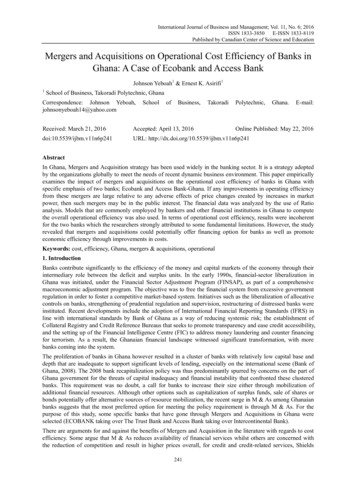
Transcription
International Journal of Business and Management; Vol. 11, No. 6; 2016ISSN 1833-3850E-ISSN 1833-8119Published by Canadian Center of Science and EducationMergers and Acquisitions on Operational Cost Efficiency of Banks inGhana: A Case of Ecobank and Access BankJohnson Yeboah1 & Ernest K. Asirifi11School of Business, Takoradi Polytechnic, GhanaCorrespondence: Johnson akoradiPolytechnic,Received: March 21, 2016Accepted: April 13, 2016doi:10.5539/ijbm.v11n6p241URL: il:Online Published: May 22, 2016AbstractIn Ghana, Mergers and Acquisition strategy has been used widely in the banking sector. It is a strategy adoptedby the organizations globally to meet the needs of recent dynamic business environment. This paper empiricallyexamines the impact of mergers and acquisitions on the operational cost efficiency of banks in Ghana withspecific emphasis of two banks; Ecobank and Access Bank-Ghana. If any improvements in operating efficiencyfrom these mergers are large relative to any adverse effects of price changes created by increases in marketpower, then such mergers may be in the public interest. The financial data was analyzed by the use of Ratioanalysis. Models that are commonly employed by bankers and other financial institutions in Ghana to computethe overall operational efficiency was also used. In terms of operational cost efficiency, results were incoherentfor the two banks which the researchers strongly attributed to some fundamental limitations. However, the studyrevealed that mergers and acquisitions could potentially offer financing option for banks as well as promoteeconomic efficiency through improvements in costs.Keywords: cost, efficiency, Ghana, mergers & acquisitions, operational1. IntroductionBanks contribute significantly to the efficiency of the money and capital markets of the economy through theirintermediary role between the deficit and surplus units. In the early 1990s, financial-sector liberalization inGhana was initiated, under the Financial Sector Adjustment Program (FINSAP), as part of a comprehensivemacroeconomic adjustment program. The objective was to free the financial system from excessive governmentregulation in order to foster a competitive market-based system. Initiatives such as the liberalization of allocativecontrols on banks, strengthening of prudential regulation and supervision, restructuring of distressed banks wereinstituted. Recent developments include the adoption of International Financial Reporting Standards (IFRS) inline with international standards by Bank of Ghana as a way of reducing systemic risk; the establishment ofCollateral Registry and Credit Reference Bureaus that seeks to promote transparency and ease credit accessibility,and the setting up of the Financial Intelligence Centre (FIC) to address money laundering and counter financingfor terrorism. As a result, the Ghanaian financial landscape witnessed significant transformation, with morebanks coming into the system.The proliferation of banks in Ghana however resulted in a cluster of banks with relatively low capital base anddepth that are inadequate to support significant levels of lending, especially on the international scene (Bank ofGhana, 2008). The 2008 bank recapitalization policy was thus predominantly spurred by concerns on the part ofGhana government for the threats of capital inadequacy and financial instability that confronted these clusteredbanks. This requirement was no doubt, a call for banks to increase their size either through mobilization ofadditional financial resources. Although other options such as capitalization of surplus funds, sale of shares orbonds potentially offer alternative sources of resource mobilization, the recent surge in M & As among Ghanaianbanks suggests that the most preferred option for meeting the policy requirement is through M & As. For thepurpose of this study, some specific banks that have gone through Mergers and Acquisitions in Ghana wereselected (ECOBANK taking over The Trust Bank and Access Bank taking over Intercontinental Bank).There are arguments for and against the benefits of Mergers and Acquisition in the literature with regards to costefficiency. Some argue that M & As reduces availability of financial services whilst others are concerned withthe reduction of competition and result in higher prices overall, for credit and credit-related services, Shields241
www.ccsenet.org/ijbmInternational Journal of Business and ManagementVol. 11, No. 6; 2016(2004).1.1 Problem StatementTheoretically it has been argued that as firms grow and their scale of operation expand, their average cost ofoperation reduces up to an optimal point beyond which diseconomy set in. Thus firms become more efficient atabsorbing fixed cost as they grow to an optimal size. However, if growth occurs through Mergers andAcquisition, factors such as diversification, management reconstitution and pooling together of complementarycapabilities could further promote efficiency. On the contrary, factors such as costs associated with mergers andacquisitions, downsizing disruptions, culture clashes, and managerial turf battles and excessive use of marketpower could lead to inefficiencies.The trade-off between these enabling and disenabling factors determine, to a large extent, the success, efficiencyand profitability of banks that have expanded through M & A. This has led to argument, in literature for andagainst the idea that firm growth through M & A leads to improved efficiency.1.2 Research QuestionsThe following research questions were formulated to guide the study. Are Banks in Ghana better at controlling operational costs after Mergers and Acquisitions? Are Mergers and Acquisitions recommendable growth options for Banks in Ghana? To what extent has 2008 regulatory capital directive impacted on cost efficiency on banks integratedthrough Mergers and Acquisitions?1.3 Objectives of the StudyThe main objective of the study was to assess the extent to which mergers and acquisition have impacted onoperational cost efficiency of selected banks in Ghana (Ecobank and Access Bank).Other objectives include the following: To determine whether Banks in Ghana are better at controlling operational cost after Mergers andAcquisitions To assess whether M & As are the recommendable growth options for Banks in Ghana To ascertain the extent to which the 2008 regulatory capital directive has impacted on cost efficiency inbanks after M & A.2. Literature Review2.1 Efficiency TheoriesSubstantial evidence exists in literature in support of bigger scale of operations. The theoretical argument forbusiness expansion through mergers and acquisitions is efficiency gains through the implementation ofoperational improvements, replacement of inefficient management, rationalization of existing branch networks,etc. (Akoena et al., 2007) Following are some theories on efficiency gains through M&As.2.2 Differential Efficiency TheoryAccording to this theory an acquiring firm will be able to increase its efficiency in the areas where the acquiredfirm is superior (Ivey, 1995). That is, if the management of firm A is more efficient than firm B (e.g. in processesand procedures) and if firm A acquires firm B, the efficiency of firm B is likely to be brought up to the level offirm A. The theory implies that some firms operate below their potential and as a result have below averageefficiency. Such firms are most vulnerable to acquisition by other more efficient firms in the same industry. Thisis because firms with greater efficiency would be able to identify firms with good potential but operating atlower efficiency (Ivey, 1995).2.3 Inefficient Management TheoryThis simply implies that the management of one company in a potential M&A bid is performing below itspotential. Management restructuring is a common phenomenon that accompanies M&A. It is commonly the casethat the re-constituted management team is more effective and efficient at handling the helms of affairs of thenewly formed organization.2.4 SynergySynergy refers to the type of reactions that occur when two substances or factors combine to produce a greatereffect together than that which the sum of the two operating independently could account for. The ability of a242
www.ccsenet.org/ijbmInternational Journal of Business and ManagementVol. 11, No. 6; 2016combination of two firms can be more profitable than the two firms individually. Coyle (2010) therefore,concludes that companies engage in mergers and acquisitions to create synergies.Synergy takes the form of revenue enhancement and cost savings. By merging, the companies hope tosubstantially reduce costs and improve revenue through staff reduction, economies of scale, complementarycapability fitting, acquiring new technology, improving market reach, etc. Three forms of synergy have beencategorized; financial synergy, operational synergy and strategic synergy. According to Sinkey (2002) M&Aactivities achieves synergy through economies of scale and scope, lower distribution or marketing costs orelimination of redundant assets.2.5 Information HypothesisThis contends that the bidders of M&A deals have private information about the target that permits them toidentify undervalued firms (Sinkey, 2002). A key object of virtually all M&As is to create a merger whose valueis greater than the sum of the individual units. Paying less for a firm of higher value is key to the achievement ofthis goal.2.6 Strategic Re-Alignment of Changing EnvironmentIt suggests that the firm use the strategy of M&As as ways to rapidly adjust to changes in their externalenvironments. When a company has an opportunity of growth available only for a limited period of times lowinternal growth may not be sufficient. Example is the bank recapitalization policy in Ghana in 2008 whichtriggered a wave of M&As.2.7 Diversification HypothesisThis is where consolidated banks are able to effectively deepen the broaden their investment portfolio due totheir larger size, prominent stature, greater geographical spread, and/broader industrial coverage, allowing for abetter diversification of risks (Akhavein et al., 1997). Thus the market rewards merging firms for an improveddiversification of loan risks by allowing them to hold higher loan/asset ratio for a slightly increased leverageratio.2.8 M&A FailuresAlthough mergers and acquisitions have the potential to boost the performance of the two companies involvedthe M&A through synergy, cost-reduction, expanded market size, improve competitiveness, among others, not allmergers and acquisition churn out the expected benefits (Straub, 2007). Failure has partly been attributed to the‘Hubris effect’ in extant literature. This hypothesis contends that, managers look for acquisition of firms for theirown potential motives and that the economic gains are not the only motivation for the acquisitions.This theory is particularly evident in case of competitive tender offer to acquire a target. The urge to win thegame often result in bidding for over-valued firms (Roll, 1986). Bidding firms are said to be infected by hubriswhen they tend to pay too much for their target firm. It is argued that so many acquisitions fall short ofexpectations because executives incorrectly match candidates to the strategic purpose of the deal, failing todistinguish between deals that might improve current operations and those that could dramatically transform thegrowth prospects of the company (HBR, 2011).(Gadeish & Ormiston, 2003) identified five major causes of M&A failure: Poor strategic rationale Mismatch of cultures. Difficulties in communicating and leading the organization. Poor integration planning and execution. Paying too much for the target company.They argue that the greatest of these factors is poor strategic rationale for carrying out mergers and acquisitionactivities. Poor strategic rationale by the acquiring firm or both firms involved in a merger will possiblyinfluence a mismatch of cultures, communication difficulties, poor integration and poor execution, among others.The cost of these difficulties and challenges usually overshadows the benefits in synergy that consolidationbrings to the new firm. (Lynch & Lind, 2002) attributes other reasons for merger failures to culture clashes, lackof appropriate risk management strategies, slow post - merger integration.A major issue in poor strategic rationale as part of the consolidating firms’ long term corporate goal is possiblythe role of managerial intent in carrying out merger decisions. McDonald et al. (2005) indicates that in their243
www.ccsenet.org/ijbmInternational Journal of Business and ManagementVol. 11, No. 6; 2016study on corporate strategies and mergers, ‘many CEOs appear happy to share the virtues of their latestacquisition, it appears few are keen to highlight their failed M&As’. There is also the risk of an overly optimisticview of the benefits of synergy which managers may attach to consolidation. In most cases, due diligence oncredit risk assessment and corporate fit is poorly done. The result is complex challenges confronting the newentity and an overestimated benefit in synergy.According to Straub (2007) the reasons for M&A successes or otherwise can generally be clustered under threefields; Strategic logic, Integration and Financial logic. The strategic school of through argue that M&As are morelikely to be successful, like the acquiring firm’s strategic decision to acquire a target firm sits well with theoverall strategic direction (Jarillo, 2003). Research in this field has concentrated on factors such as the motivesand the different types of combination, market power and economics of scale (Finkelstein, 1999). In contrast, theorganizational school of thought (integration field) is concerned with the broad question of what effectacquisitions have on individuals and organizations. Research in this area commonly concentrates on analyzingthe impact of M&A on people such as the cultural ‘fit’ and managerial ‘fit (Weber, 1996; Mark & Mirvis, 2000).Financial logic concentrates on the financial sense of M&As. Here the perspectives of the financial analyst onthe value creation potentials of firm consolidation are considered.Using four statistical methods Straub (2007) developed a framework for the three identified fields that showsthat the performance of M & As is a multi-dimensional function. According to him, for a successful deal, thefollowing key success factors for each identified field should be taken into account;Strategic Logic: Reflection by market similarities, market complementarities, market power and purchasingpower.Organizational integration: Reflected by three determinants namely acquisition experience, relative size andcultural compatibility.Financial /Price logic: Reflected by three determinants namely acquisition premium, bidding process and duediligence.All these variables are presumed to affect performance either positively or negatively. Post M&A performance ismeasured by synergy realization, relative performance (compared to competition) and absolute performance.It follows from the work of Straub (2007) and the theories reviewed so far that an acquiring firm: Achieves sync between its overall strategic direction and the strategic decision to expand operationsthrough M&A. Manages the behavioral implications of the exercise to achieve a good cultural and organizational ‘fit’ and Is able to negotiate for a good price.It is highly probable that the integration exercise will be a success.A successful integration–herein seen as a net gain between the possible gains in operational efficiency ofconsolidation (resulting from replacement of inefficient management, structures, processes, etc.) and the possibleoperational efficiency losses (price hikes from undue market power, managerial turf battles, downsizedisruptions, high associated costs, etc.) – will potentially translate into an effective and efficient post-mergerentity. An efficient firm will thus exhibit the following attributes among others: Offer range of products and services that delight customers. Deliver quality services to satisfaction and retain customers. Better control over operational and transactional costs. Less bureaucratic processes and procedures. Have efficient-oriented culture. Use modern technology to improve efficiency.2.9 Efficiency in LiteratureThe concept of bank efficiency can be viewed from many perspectives (Akoena et al., 2012). Pure technicalefficiency means the extent to which firms are able to attain maximum possible output with their input bundles atexisting scale size. Scale efficiency is considering whether firms are producing as close to their most productivescale size as possible (Akoena et al., 2012). If firms do not generate output at a scale of operations which isclosest to their most productive scale size, there exists scale inefficiencies which tend to increase the averagecosts of production.244
www.ccsenet.org/ijbmInternational Journal of Business and ManagementVol. 11, No. 6; 2016Again, X-efficiency would be looking at how proficient management is at engaging resources to produce outputthat meet or exceed customers need at the least possible cost (Berger et al., 1993). The potential is greater forcost X-efficiency gains by moving closer to the ‘best-practice’ cost frontier where cost is minimized for a givenoutput bundle. The X-efficiency empirical findings suggest that on average, banks have costs that are about 20%to 25% above those of the observed best practice banks. This result suggests that the cost efficiency could beconsiderably improved by a merger in which a relatively efficient bank acquires a relatively inefficient bank andspreads its superior management talent over more resources (Berger et al., 1993).2.10 Efficiency and ProfitabilityThe relationship between efficiency and profitability is one area that has received a lot of research attention(Soteiou & Zenios, 1997; Turati, 2003; Kumar, 2008). Demsetz, (1973) proposed the efficiency hypothesis thatstipulates that a bank which operates more efficiently than its competitors gains higher profits resulting from lowoperational costs. He stated that higher profits of banks are not due to their collusive behavior but because ofhigh efficiency level, which in turn, leads to larger market shares that banks possess. In other words, profitabilityof bank is determined not by the market concentration but by bank efficiency (Grygorenko, 2009). The equationbelow shows the relationship that exists between profitability and efficiency;ROE (PAT/NI-BT)* (PBT/OP. )* (OP. /TA)* (TA/E)& PM NI –AT/NI-BT)* (NI-BT/OP. )Where:ROE return on shareholders’ equity;PAT Profit After Tax;PM Profit Margin;NI –AT/NI-BT Tax Efficiency;PBT/OP. Inc Operating Cost Efficiency;OP.Inc/TA Asset Utilization/turnover efficiency;TA/E Equity Multiplier.The above equation (Sinkey, 2002) suggests that a firm’s profitability is contingent, inter alia, upon how efficientit is at controlling its operational costs.The ratio of Expense –to-Income (used as a proxy for operating cost efficiency) measures the overheads or costof running the bank-the major element of which is normally salaries – as percentage of income and it is used toprovide information on variation of bank cost over the banking system. According to the argument advanced byKosmidou (2008), although the relationship between expenditure and profits appears straightforward implyingthat higher expenses mean lower profits and vice versa, this may not always be the case. The reason is thathigher amounts of expenses may be associated with higher volume of banking activities and therefore higherrevenues. It is expected that this variable will have a negative impact on performance because efficient banks areexpected to operate at lower costs.According to Humphrey et al. (1997) mergers and acquisitions could raise profits in any of three major ways.First, they could improve cost efficiency, reducing costs per unit of output for a given set of output quantities andinput prices. Indeed, consultants and managers have often justified large mergers on the basis of expected costefficiency gains. Second, mergers may increase profits through improvements in profit efficiency that involvessuperior combinations of inputs and outputs. Profit efficiency is a more inclusive concept than cost efficiency,because it takes into account the cost and revenue effects of the choice of the output vector which is taken asgiven in the measurement of cost of, efficiency. Thus, a merger could improve profit efficiency withoutimproving cost efficiency if the reconfiguration of outputs associated with the merger increases revenues morethan it increases costs, or if it reduces costs more than it reduces revenues.Third, mergers may improve profits through the exercise of additional market Power in setting prices. Anincrease in market concentration or market share may allow the consolidated firm to charge higher rates for thegoods or services it produces, raising profits by extracting more surplus from consumers, without anyimprovement in efficiency.Humphrey et al. (1997) however found in their work that profit efficiency can improve, even though costefficiency has not improved.245
www.ccsenet.org/ijbmInternational Journal of Business and ManagementVol. 11, No. 6; 20162.11 Measuring Bank EfficiencyIn literature the measurement of bank performance (of which efficiency is but one) has been considered on twobroad bases: financial and non-financial efficiency (Yeh, 1996). The financial approach to measuring operationalefficiency uses financial statement variables such as expenses, profits, costs and revenue and various analyticaltechniques such as ratio analysis or the frontier approach. Financial analysts have traditionally used one or acombination of these approaches to advance their work (Yeh, 1996).A common financial ratio that bankers use to measure the overall operational efficiency is the cost/income ratio(expense/income ratio). This is a measure that broadly expresses the operating costs incurred by the bank as apercentage of its operating income. The general intent is that if a bank has a cost/income ratio of, say, 48 per cent,then for each 100 units of operating income, 48 units go out in overall operating costs – with only part of thosecosts representing back office expenses or IT specific costs. The cost/income ratio can be applied to any entitybut when it is specifically applied to a bank, it is an expression of the bank’s total operating costs over its netinterest income (interests earned on investments less the interests paid out sot depositors) plus any otheroperating income such as fees and commissions. As a result, the ratio measures not simply the efficiency of itsback office and its IT strategy but the efficiency of the whole bank, including its interest management policy, itsinvestment policy and its investment in new products or delivery channels.Although the frontier approach is said to offer a more reliable option to bank efficiency estimation thanaccounting ratios (Vitta, 1991), the latter could serve as a quick and easy tool for assessing a bank’s financialperformance. Financial ratios (a quantitative measure), where considered alongside non-financial measures, canoffer a balanced way of assessing performance (Quinn & Rohrbaugh, 1983).There are a number of studies in the literature that used non-financial measures to evaluate the effectiveness andperformance of organization (Quinn & Rohrbaugh, 1983; Venkatraman, 1986). It is reported that a good measureof performance evaluation should be meaningful. It must reflect management’s clarity about organization’scurrent situation and its viability to achieve its goals. It should be manageable as it can be handled easily basedon simple calculations and manipulation of data (Ernst & Young, 1995).Non-financial measures offer four clear advantages over measurement systems based on financial data (Umar &Olantunde, 2011). Firs, is a closer link to long-term organizational strategies .Second, critics of traditionalmeasures argue that drivers of success in many industries are “intangible assets” such as intellectual capital andcustomer loyalty, rather than the “hard assets” allowed on to balance sheets. Third, non-financial measures canbe better indicators of future financial performance. Finally, the choice of measures should be based onproviding information about managerial actions and the level of “noise” in the measures. Noise refers to changesin the performance measure that are beyond the control of the manager of organization, ranging from changes inthe economy to luck: good or bad (Ittner & Larcker, 2000).3. MethodologyThe study is both descriptive and explanatory in purpose. The objective of the study was to assess how M & Ahas impacted on operational cost efficiency of selected commercial banks in Ghana, particularly, following the2008 bank recapitalization. This presupposes that the data for the study should cover both pre and post M & Aperiods and preferably starting from 2008.The study employed financial data analysis to assess cost efficiency of selected consolidated banks. The aim wasto enable the researchers make a balanced assessment of efficiency performance (Saner, 1998).Financial secondary data were extracted from the annual statements of comprehensive income statements of theselected banks. These statements were sourced from the banking supervision department of the bank of Ghana,the banks websites and the bank’s headquarters. Data for pre and post consolidation periods, spanning five years(2008-2012) for the two consolidated banks were used.The financial data was analyzed by the use of Ratio analysis. The study used models that are commonlyemployed by bankers and other financial institutions in Ghana to compute the overall operational efficiency. Forexample in estimating and reporting on the efficiencies of Ghanaian banks, Price Water Coopers-Ghana usesCost-Income Ratio approach (Ghana Banking Survey reports) which is employed in this study. Annualpercentage increment in Impairment costs and operational expenses (the components of operational cost) werealso estimated to help understand which costs or expenses significantly fluctuates during mergers and acquisitionrestructuring.246
www.ccsenet.org/ijbmInternational Journal of Business and ManagementVol. 11, No. 6; 2016Operating Cost-Income Ratio Total Operating Cost/Operation IncomeAssets Impairment Cost Operational ExpenseOperating Income%Incremental Impairment Cost%Incremental Expense Cost4. Financial Data Analysis (Cost Efficiency Assessment)Table 1. Operating costs analysis – Ecobank (amounts expressed in thousands of Ghana ,888107,189(GH )236,263128,90089,50487,19963,298P BT (GH )196,185102,61990,65872,68943,891P BT MRG .05236,263128,90089,50487,19963,298Op. Exp (GH )210,948122,74383,74277,68157,505Impairment (GH )25,3156,1575,7629,5185,793Incr. OP. Cost (GH )107,36339,3962,30523,90129,564Incr. OP. Exp (GH )88,20539,0016,06120,17624,362Incr. Imp. Ex (GH OP. INC (GH )Total OP. COSTCOST-INCRATIO (%)Components of Op.CostTotalOP.Cost(GH )Op. Exp (%)89.2995.22Impairment (%)10.714.78Incr. Op. Cost (%)83.2944.022.6437.7687.64Incr. Op. Ex (%)71.8646.577.8035.0973.51Incr. Impair. Ex (%)311.166.86-39.4664.30880.20Source: Bank’s annual financial statements and researchers calculations.Table 1 above shows the operating cost and its corresponding incremental costs of Ecobank spanning five years(2008 to 2012). Two broad subdivisions of operating costs; operating expenses and impairment of financialassets, and their corresponding incremental costs are also shown. Operating income was included to enable theresearchers compute the ratio of cost to income (a proxy for estimating cost efficiency) and to also assess theimpact of operating costs on the profit margins of Ecobank. The years were carefully selected to cover both preacquisition and post-acquisition period (Note: the acquisition exercise occurred between late 2011 and early2012).4.1 Pre-Acquisition Cost Performance (Ecobank)The results indicate that in 2008, Ecobank recorded the highest cost-income ratio and incremental costs of 59.05%and 87.64% respectively, significantly driven by impairment costs (880.2% increases) over the previous year.Between 2008 and 2010, the bank improved upon its operational cost efficiency. The cost-income ratiodecreased from 59.05% to 49.68% during this period. Operational expenses (46.57%). On the average the bank’scost-income ratio in the pre-acquisition period was 54.74% (Performance average for the four pre-acquisitionyears).4.2 Post-Acquisition Cost Performance (Ecobank)In 2012, the first post-acquisition year of operation, Ecobank incurred 83.29% increase in operational cost,mainly driven by impairment cost (311.16% increases). This increase was however matched by a higher247
www.ccsennet.org/ijbmInternnational Journall of Business andd ManagementVol. 11, No. 6; 2016percentagee increase in inncome (86.76%%), thereby maaintaining the cost-income raatio at a lowerr position (54.663%)than in 2011. The graphs below depictt profit and coost margins (Fiigure 4.1a) andd incremental costs (Figure 4.1b)4for Ecobannk over a five yeary term (covvering pre - acqquisition perioods).Figure 1b. AAnalysisFigure 1a. AnnalysisFigure 1a shows that in the pre-acquissition period, ccost margin deccreased between 2008 and 22010 (betteringg costefficiency)) and sharplyy increased bbetween 2010 and 2011. IIt also showss that betweenn 2011 and 2012(post-acquuisition) cost marginsmdropped. This showws that with thhe exception oof 2011 Ecobaank demonstrated ayear on y
In Ghana, Mergers and Acquisition strategy has been used widely in the banking sector. It is a strategy adopted by the organizations globally to meet the needs of recent dynamic business environment. This paper empirically examines the impact of mergers and acquisitions on the operational cost efficiency of banks in Ghana with specific emphasis of two banks; Ecobank and Access Bank-Ghana. If .
